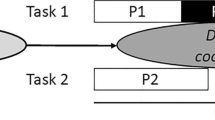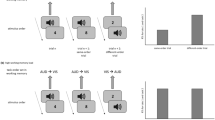Abstract
To examine whether hierarchical higher level task representations comprising the task sets of Task 1 (T1) and Task 2 (T2) are activated within each trial in dual-task situations, we combined the psychological refractory period (PRP) paradigm with the task-pair switching logic (Hirsch et al. 2017). In Experiment 1, in which subjects switched between task-pairs including a varying T1 and a constant T2, we found a PRP effect (i.e., worse performance with short stimulus onset asynchrony [SOA] than with long SOA) and task-pair switch costs in T1 and T2 (impaired performance in task-pair switches compared to task-pair repetitions). However, since in Experiment 1 there were no forward and backward response–response compatibility effects that indicated interference between T1 and T2, we could not exclude that the activation of T1 persisted into the next trial despite the intervening T2, and hence, that task-pair switch costs are due to repetition-priming effects of T1 across task-pairs rather than due to persisting activation of task-pair representations. In Experiment 2, we used a modified task-pair switching logic with a constant T1 and a varying T2, and replicated task-pair switch costs under conditions that not only rule out repetition-priming effects of T1 across task-pairs as the source of task-pair switch costs but also disentangle the effects of switching task-pairs from those of switching T1. These effects were associated in previous studies using the original task-pair switching logic. Thus, the findings of the present study strongly suggest that hierarchical higher level task representations are activated during dual-task processing.


Similar content being viewed by others
Notes
To examine whether this trend was due to response grouping, we analysed inter-response intervals (IRIs; i.e., time interval between the response for T1 and for T2). We considered IRIs less than 200 ms to be indicative of response grouping (e.g., De Jong 1993). Overall, there were 3.8% trials with IRIs less than 200 ms. Moreover, the analysis showed that one participant grouped the responses in 20.9% of the trials. The result pattern did not change if the subject who showed an extreme grouping behaviour and the trials with IRIs less than 200 ms were excluded from all analyses. However, the SOA effect on T1 was statistically smaller, F(1, 22) = 3.23, p = .09, η p² = 0.13. In Experiment 1, we identified 0.56% trials with IRIs less than 200 ms. The result pattern did not change if these trials were discarded from all analyses. The proportion of grouped trials was larger in Experiment 2 than in Experiment 1. The main difference between the experiments is that in Experiment 1, T1 varied and T2 remained constant across task-pairs, whereas in Experiment 2, T1 was constant and T2 varied across task-pairs. Thus, in Experiment 2, subjects had to maintain the task-pair cue during T1 processing and until the presentation of S2 in working memory, whereas in Experiment 1, the task-pair cue was already relevant for T1. The maintenance of the task-pair cue in working memory during T1 processing or until the presentation of S2 might have promoted response grouping in Experiment 2.
To examine whether task-pair switch costs differ depending on whether the SOA in the previous trial was repeated or switched, we ran additional ANOVAs with the within-subjects variables task-pair sequence (task-pair switch vs. task-pair repetition) and SOA sequence (SOA switch vs. SOA repetition) for trials with a short SOA. In the following, to avoid redundancy, we report only effects including the SOA sequence variable. In Experiment 1, we exclude one participant from all analysis due to an overall error rate of <25%. For the error rates in T2, there was a trend toward more erroneous responses in SOA repetition trials than in SOA switch trials (6.9 vs. 5.6%). However, like all other effects, all ps > 0.15, the main effect of SOA sequence was not significant, F(1, 22) = 3.69, p = .068, η p² = 0.14. In Experiment 2, task-pair switch costs for the error rates in T2 were numerically larger in SOA switch trials than in SOA repetition trials (5.6 vs. 2.1%). However, the interaction of task-pair sequence and SOA was not significant, F(1, 22) = 3.72, p = .066, η p² = 0.14. All other effects were non-significant, too, all ps > 0.16.
References
Allport, A., Styles, E. A., & Hsieh, S. (1994). Shifting intentional set: Exploring the dynamic control of tasks. In C. Umiltà & M. Moscovitch (Eds.), Conscious and nonconscious information processing: Attention and performance XV. (pp. 421–452). Cambridge: MIT Press.
Altmann, E. M. (2006). Task switching is not cue switching. Psychonomic Bulletin and Review, 13, 1016–1022. doi:10.3758/BF03213918.
Arrington, C. M., Logan, G. D., & Schneider, D. W. (2007). Separating cue encoding from target processing in the explicit task-cuing paradigm: Are there true task switch effects? Journal of Experimental Psychology: Learning, Memory, and Cognition, 33, 484–502. doi:10.1037/0278-7393.33.3.484.
De Jong, R. (1993). Multiple bottlenecks in overlapping task performance. Journal of Experimental Psychology: Human Perception and Performance, 19, 965–980. doi:10.1037/0096-1523.19.5.965.
De Jong, R. (1995). The role of preparation in overlapping-task performance. Quarterly Journal of Experimental Psychology, 48 A, 2–25. doi:10.1080/14640749508401372.
Fischer, R., & Dreisbach, G. (2015). Predicting high levels of multitasking reduces between-tasks interactions. Journal of Experimental Psychology: Human Perception and Performance, 41, 1482–1487. doi:10.1037/xhp0000157.
Gade, M., & Koch, I. (2007). The influence of overlapping response sets on task inhibition. Memory & Cognition, 35, 603–609. doi:10.3758/BF03193298.
Hahn, S., Andersen, G. J., & Kramer, A. F. (2003). Multidimensional set switching. Psychonomic Bulletin & Review, 10, 503–509. doi:10.3758/BF03196513.
Heuer, H. (1991). Motor constraints in dual-task performance. In D. L. Damos (Ed.), Multiple task performance (pp. 173–204). London: Taylor & Francis.
Hirsch, P., Nolden, S., & Koch, I. (2017). Higher-order cognitive control in dual-tasks: Evidence from task-pair switching. Journal of Experimental Psychology: Human Perception and Performance.
Hommel, B. (1998). Automatic stimulus-response translation in dual-task performance. Journal of Experimental Psychology: Human Perception and Performance, 24, 1368–1384. doi:10.1007/s00426-002-0100-y.
Hommel, B. (2004). Event files: Feature binding in and across perception and action. Trends in Cognitive Science, 8, 494–500. doi:10.1016/j.tics.2004.08.007.
Hübner, R., Futterer, T., & Steinhauser, M. (2001). On attentional control as a source of residual shift costs: Evidence from two-component task shifts. Journal of Experimental Psychology: Learning, Memory, & Cognition, 27, 640–653. doi:10.1037//0278-7393.27.3.640.
Jost, K., Mayr, U., & Rösler, F. (2008). Is task switching nothing but cue priming? Evidence from ERPs. Cognitive, Affective, and Behavioral Neuroscience, 8, 74–84. doi:10.3758/CABN.8.1.74.
Keller, P. E., & Koch, I. (2006). Exogenous and endogenous response priming with auditory stimuli. Advances in Cognitive Psychology, 2, 269–276. doi:10.2478/v10053-008-0061-9.
Keller, P. E., & Koch, I. (2008). Action planning in sequential skills: Relations to music performance. Quarterly Journal of Experimental Psychology, 6, 275–291. doi:10.1080/17470210601160864.
Kiesel, A., Steinhauser, M., Wendt, M., Falkenstein, M., Jost, K., Philipp, A. M., & Koch, I. (2010). Control and interference in task switching—a review. Psychological Bulletin, 136, 849–874. doi:10.1037/a0019842.
Kleinsorge, T. (2004). Hierarchical switching with two types of judgment and two stimulus dimensions. Experimental Psychology, 51, 145–149. doi:10.1027/1618-3169.51.2.145.
Kleinsorge, T., & Heuer, H. (1999). Hierarchical switching in a multi-dimensional task space. Psychological Research Psychologische Forschung, 62, 300–312. doi:10.1007/s004260050060.
Kleinsorge, T., Heuer, H., & Schmidtke, V. (2001). Task-set reconfiguration with binary and three-valued task dimensions. Psychological Research Psychologische Forschung, 65, 192–201. doi:10.1007/s004260000051.
Kleinsorge, T., Heuer, H., & Schmidtke, V. (2004). Assembling a task space: Global determination of local shift costs. Psychological Research, 68, 31–40. doi:10.1007/s00426-003-0134-9.
Koch, I., Gade, M., Schuch, S., & Philipp, A. M. (2010). The role of inhibition in task switching: A review. Psychonomic Bulletin & Review, 17, 1–14. doi:10.3758/PBR.17.1.1.
Lien, M. C., & Ruthruff, E. (2004). Task switching in a hierarchical task structure: Evidence for the fragility of the task repetition benefit. Journal of Experimental Psychology: Learning, Memory, and Cognition, 30, 697–713. doi:10.1037/0278-7393.30.3.697.
Logan, G. D. (1988). Toward an instance theory of automatization. Psychological Review, 95, 492–527. doi:10.1037/0033-295X.95.4.492.
Luria, R., & Meiran, N. (2003). Online order control in the psychological refractory period paradigm. Journal of Experimental Psychology: Human Perception and Performance, 29, 556–574. doi:10.1037/0096-1523.29.3.556.
Luria, R., & Meiran, N. (2006). Dual route for subtask order control: Evidence from the psychological refractory paradigm. The Quarterly Journal of Experimental Psychology, 59, 720–744. doi:10.1080/02724980543000060.
Mayr, U., & Keele, S. W. (2000). Changing internal constraints on action: the role of backward inhibition. Journal of Experimental Psychology: General, 1, 4–26. doi:10.10371/0096-3445.129.1.4.
Miller, J. (2006). Backward crosstalk effects in psychological refractory period paradigms: Effects of second-task response type on first-task response latencies. Psychological Research Psychologische Forschung, 70, 484–493. doi:10.1007/s00426-005-0011-9.
Monsell, S., & Mizon, G. A. (2006). Can the task-cuing paradigm measure an endogenous task-set reconfiguration process? Journal of Experimental Psychology: Human Perception and Performance, 32, 493–516. doi:10.1037/0096-1523.32.3.493.
Morey, R. D. (2008). Confidence intervals from normalized data: A correction to Cousineau (2005). Tutorials in Quantitative Methods for Psychology, 4, 61–64.
Navon, D., & Miller, J. (2002). Queuing or sharing? A critical evaluation of the single-bottleneck notion. Cognitive Psychology, 44, 193–251. doi:10.1006/cogp.2001.0767.
Pashler, H. (1994). Dual-task interference in simple tasks: Data and theory. Psychological Bulletin, 116, 358–377. doi:10.1037/0033-2909.116.2.220.
Philipp, A., & Koch, I. (2010). The integration of task-set components into cognitive task representations. Psychologica Belgica, 50, 383–411. doi:10.5334/pb-50-3-4-383.
Rangelov, D., Töllner, T., Müller, H. J., & Zehetleitner, M. (2013). What are task-sets: A single, integrated representation or a collection of multiple control representations? Frontierts in Human Neuroscience. doi:10.3389/fnhum.2013.00524.
Rogers, R. D., & Monsell, S. (1995). Costs of a predictable switch between simple cognitive tasks. Journal of Experimental Psychology: General, 124, 207–231. doi:10.1037/0096-3445.124.2.207.
Rusconi, E., Kwan, B., Giordano, B. L., Umiltà, C., & Butterworth, B. (2006). Spatial representation of pitch height: The SMARC effect. Cognition, 99, 113–129. doi:10.1016/j.cognition.2005.01.004.
Schneider, D. W., & Logan, G. D. (2006). Hierarchical control of cognitive processes: Switching tasks in sequences. Journal of Experimental Psychology: General, 135, 623–640. doi:10.1037/0096-3445.135.4.623.
Schuch, S., & Koch, I. (2004). The costs of changing the representation of action: Response repetition and response-response compatibility in dual tasks. Journal of Experimental Psychology: Human Perception and Performance, 30, 566–582. doi:10.1037/0096-1523.30.3.566.
Szameitat, A. J., Lepsien, J., von Cramon, D. Y., Sterr, A., & Schubert, T. (2006). Task-order coordination in dual-task performance and the lateral prefrontal cortex: An event-related fMRI study. Psychological Research Psychologische Forschung, 70, 541–552. doi:10.1007/s00426-005-0015-5.
Szameitat, A. J., Schubert, T., Müller, K., & von Cramon, D. Y. (2002). Localization of executive functions in dual-task performance with fMRI. Journal of Cognitive Neuroscience, 14, 1184–1199. doi:10.1162/089892902760807195.
Ulrich, R., & Miller, J. (2008). Response grouping in the psychological refractory period (PRP) paradigm: Models and contamination effects. Cognitive Psychology, 57, 75–121. doi:10.1016/j.cogpsych.2007.06.004.
Vandierendonck, A., Christiaens, E., & Liefooghe, B. (2008). On the representation of taks information in task switching: Evidence from task and dimension switching. Memory & Cognition, 36, 1248–1261. doi:10.3758/MC.36.7.1248.
Welford, A. T. (1952). The ‘psychological refractory period’ and the timing of high-speed performance – A review and a theory. British Journal of Psychology, 43, 2–19. doi:10.1111/j.2044-8295.1952.tb00322.x.
Author information
Authors and Affiliations
Corresponding author
Ethics declarations
Conflict of interest
The authors declare that they have no conflict of interest (financial or non-financial). Moreover, we have full control of all primary data and we agree to allow the journal to review the data if requested.
Ethical approval
All procedures performed in the present study involving human participants were in accordance with the ethical standards of the institutional and/or national research committee and with the 1964 Helsinki declaration and its later amendments or comparable ethical standard.
Funding
This study was not funded by a research grant.
Informed consent
Informed consent was obtained from all individual participants included in the study.
Rights and permissions
About this article
Cite this article
Hirsch, P., Nolden, S., Philipp, A.M. et al. Hierarchical task organization in dual tasks: evidence for higher level task representations. Psychological Research 82, 759–770 (2018). https://doi.org/10.1007/s00426-017-0851-0
Received:
Accepted:
Published:
Issue Date:
DOI: https://doi.org/10.1007/s00426-017-0851-0




